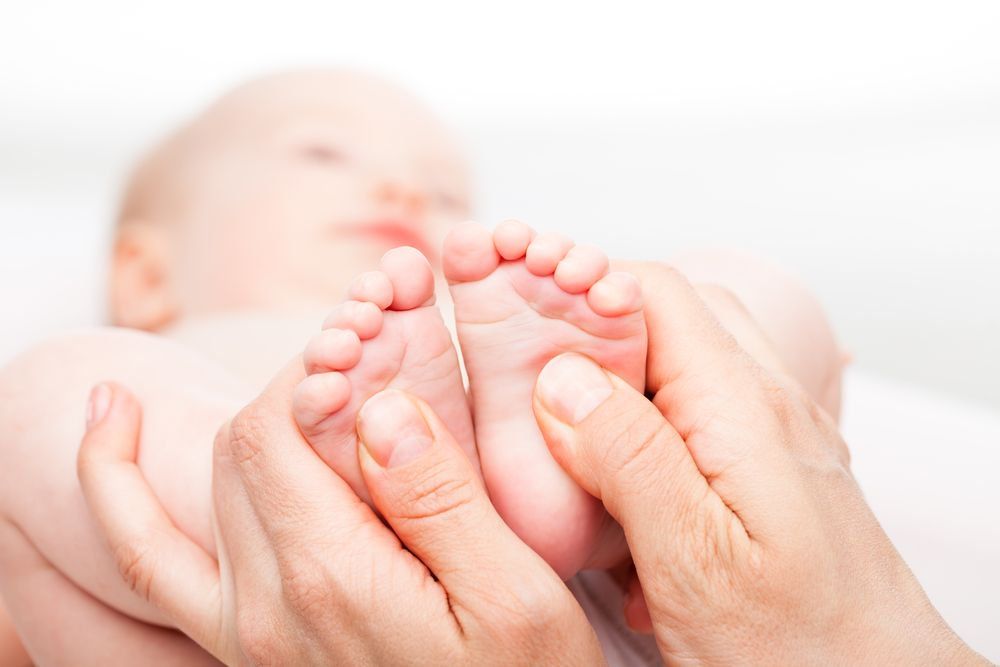Article
Spinal Muscular Atrophy: Clinical Aspects
Author(s):
Advances in the diagnosis and management of SMA include molecular genetic testing and the FDA approval of a disease-modifying therapy.
Image ©DmitryNaumov/Shutterstock.com

Spinal muscular atrophy (SMA) is the most common genetic disease of the motor neuron and results in degeneration of motor neurons in both the spinal cord and the brain stem. Patients have diffuse, symmetric muscle weakness that is greater proximally and in the lower limbs; hyporeflexia or areflexia; and progressive respiratory insufficiency. Non-motor manifestations are rare, although sensory involvement, cardiac defects, gastrointestinal and autonomic dysfunction, and endocrine abnormalities have been reported. The impact of these atypical features is not well-defined.1
Clinically, SMA is often divided into five types, primarily based on age of clinical onset:
• Infants with type 0 (prenatal onset) SMA are profoundly weak and require respiratory support at birth. Life expectancy is less than 6 months.
• The clinical presentation of type 1 SMA (Werdnig-Hoffmann disease) begins after birth but before age 6 months. Affected infants are not expected to be able to meet sitting, standing, or walking milestones, and most die before the age of 2 years from respiratory failure.
• SMA type 2 usually manifests between 6 and 18 months of age. These children may grow to sit unassisted but are often unable to stand or walk. The range of life expectancy is broad at 10 to 40 years.
• Children with type 3 SMA (Kugelberg-Welander disease) and those with type 4 SMA present after age 18 months and after 5 years, respectively. These children usually meet gross motor milestones (sitting, standing, and walking). Patients with type 4 SMA are typically less affected than those with type 3 SMA and are less likely to require assistance with ambulation as the disease progresses. Both SMA type 3 and type 4 are associated with a normal lifespan.
Known genetic alterations linked to SMA
Approximately 95% of SMA cases are chromosome 5q-related and have an autosomal recessive inheritance pattern. Homozygous deletions in exon 7 of the survival motor neuron 1 gene (SMN1, located on chromosome 5q13.2) account for 95% of 5q-related SMA. According to Arnold and colleagues, “essentially all other patients with SMN-related SMA will be compound heterozygotes with a single SMN1 deletion and a frameshift, nonsense or missense mutation in the other SMN1 copy.”1 These alterations in the SMN1 gene result in deficiency of the SMN protein. The cell loss in SMA is related to low, but not absent, levels of SMN protein. This protein is believed to play a role in motor neuron mRNA synthesis, a critical cell function.2
In SMA, the survival motor neuron 2 gene (SMN2) acts as a modifying gene. The SMN1 and SMN2 genes are more than 99% identical, with the main difference of a C to T transition in the SMN2 gene within exon 7. Because of this transition, the majority of mRNA from the SMN2 gene will code for a truncated and non-functional SMN protein. However, because of alternative splicing events, about 10% of SMN2 mRNA will contain exon 7 and code for a full-length, functional SMN protein. These SMN2-derived proteins partially compensate for the loss of the SMN1 coded protein and contribute to the differences in SMN protein activity and phenotypic expression among individuals with SMA.
In general, the predicted SMN2 copy number is higher for later onset and less severe cases of SMA. For example, infants with type 0 (prenatal onset) SMA generally have 1 copy of the SMN2 gene, while patients with type 4 (late onset) are expected to have 4 or more copies.
The non-5q spinal muscular atrophies form a small minority of SMA cases (4% to 5%) and are clinically and genetically heterogeneous. The non-5q spinal muscular atrophies are generally classified by distribution of weakness and mode of inheritance.3
Clinically available testing
Molecular genetic testing with targeted mutation analysis is the current standard tool for the efficient and specific diagnosis of SMA. Testing can confirm the diagnosis of SMA in 95% of patients (regardless of disease severity) by detection of homozygous deletions in exon 7 of the SMN1 gene.2 If a homozygous deletion is not present, SMN1 dosage testing can confirm a single deletion, and sequencing of the SMN1 gene should then be performed to look for a point mutation in the other SMN1 gene copy. Absence of a pathogenic mutation in SMN1 casts serious doubt on the diagnosis, and other conditions with similar presentations should be considered.1
Although characteristic changes on electromyography and muscle biopsy can be found in patients with SMA, the availability of molecular genetic testing has meant that these tests are not often used.
All affected families with SMA should be offered genetic counseling. The American College of Medical Genetics recommends offering carrier testing to all couples regardless of race or ethnicity. The American College of Obstetricians and Gynecologists recommends offering screening for SMA to all women who are considering pregnancy or are currently pregnant.1
Treatment of SMA
The mainstay of treatment for SMA is supportive therapy, including nutrition and respiratory assistance and management of complications of progressive muscle weakness. Recently, the FDA approval of a disease-modifying therapy, nusinersen, markedly altered the SMA treatment landscape. Nusinersen is an antisense oligonucleotide that changes the splicing of the SMN2 gene to increase the expression of normally functioning, full-length SMN protein.2
Nusinersen is administered intrathecally. Treatment begins with three loading doses (12 mg per dose), each 14 days apart, with a fourth dose given 30 days after the third dose. Subsequent single maintenance doses are given every 4 months.
The ENDEAR trial compared a group of infants with SMA who were treated with nusinersen with similar infants receiving sham treatments. The infants treated with nusinersen had lower mortality, greater improvements in motor milestones, and less need for permanent respiratory support than the control infants.4 Based on these findings, treatment with nusinersen is now recommended for most infants with SMA.
Nusinersen is also recommended for children aged 2 to 12 years who: (1) have onset of symptoms at greater than 6 months of age; (2) are able to sit independently at the time of treatment (but were never able to walk independently); and (3) have an estimated life expectancy of greater than 2 years. These criteria are based on the inclusion criteria for the CHERISH study, which found a mean improvement of 3.9 points after 15 months of nusinersen treatment on the Hammersmith Functional Motor Scale Expanded, compared with an average decline of 1.0 point in the control group.5 This study was stopped early for benefit at a pre-specified interim analysis point. Exclusion criteria for the same study included: (1) the need for invasive or non-invasive ventilation for more than 6 hours in a 24-hour period; (2) the need for a gastric tube for the majority of feeds; (3) severe contractures or scoliosis; and (4) cachexia.
The most common adverse effects associated with nusinersen therapy in the study were respiratory tract infections and constipation. The investigators also found an increased risk of renal toxicity, thrombocytopenia, and coagulation abnormalities.6 There are limited published data on nusinersen in older children, adults, and patients with advanced disease.
Other emerging treatments include gene replacement therapy for SMN1, modulation of SMN2 full-length protein, and prosurvival therapies for motor neurons and muscle and nerve functional enhancement; however, larger studies are needed before widespread clinical use is feasible.7
Dr Frey is Associate Professor of Neurology at the University of Colorado School of Medicine in Aurora. She is also the Director of the Neurofeedback Clinic at the University of Colorado Hospital.
Disclosures:
Dr Frey reports no conflicts of interest concerning the subject matter of this article.
References:
1. Arnold WD, Kassar D, Kissel JT. Spinal muscular atrophy: diagnosis and management in a new therapeutic era. Muscle Nerve. 2015;51:157-167.
2. Bodamer OA. Spinal muscular atrophy. In: Dashe JF, ed. UpToDate 2019. https://www.uptodate.com/contents/spinal-muscular-atrophy Accessed April 25, 2019.
3. Darras BT. Non-5q spinal muscular atrophies: the alphanumeric soup thickens. Neurology. 2011;77:312-314.
4. Finkel RS, Mercuri E, Darras BT, et al. Nusinersen versus sham control in infantile-onset spinal muscular atrophy. N Engl J Med. 2017;377:1723-1732.
5. Mercuri E, Darras BT, Chiriboga CA, et al. Nusinersen versus sham control in later-onset spinal muscular atrophy. N Engl J Med. 2018;378:625-635.
6. SPINRAZA (nusinersen) injection, for intrathecal use [prescribing information]. Cambridge, MA: Biogen. Revised October 10, 2018. www.accessdata.fda.gov/drugsatfda_docs/label/2016/209531lbl.pdf Accessed April 25, 2019.
7. Farrar MA, Park SB, Vucic S, et al. Emerging therapies and challenges in spinal muscular atrophy. Ann Neurol. 2017;81:355-368.
Newsletter
Keep your finger on the pulse of neurology—subscribe to NeurologyLive for expert interviews, new data, and breakthrough treatment updates.




